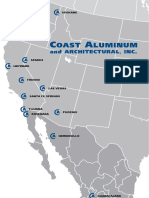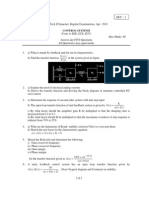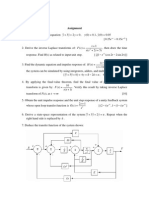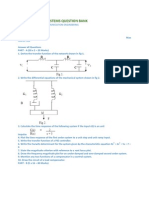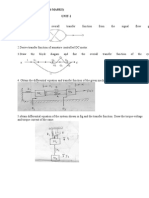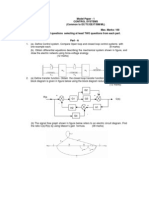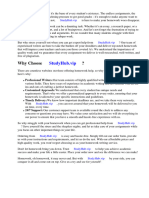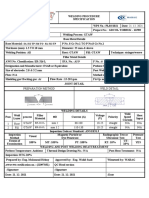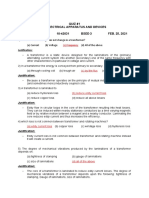Control Systems
Uploaded by
padmajasivaControl Systems
Uploaded by
padmajasivaTo get more 'n' more just vist : www.examsadda.
com
Code No: V0223
R07
SET - 1
II B.Tech II Semester, Supplementary Examinations, April/May 2012 CONTROL SYSTEMS (Com. to EEE, ECE, ECC) Time: 3 hours Max. Marks: 80 Answer any FIVE Questions All Questions carry Equal Marks ~~~~~~~~~~~~~~~~~~~~~+
b) Discuss the advantages and disadvantages of closed loop control systems 2. a) Explain the working principle of AC servomotor. b) Find the overall gain C(S)/R(S) for the block diagram shown below.
w w
.e
xa
To get more 'n' more just vist : www.creativeworld9.com
sa
1 of 2
dd
a.
co
1.
a) Write the differential equations governing the mechanical system shown below and determine the transfer function Y1(s)/F(s).
To get more 'n' more just vist : www.examsadda.com
Code No: V0223
R07
SET - 1
3.
a) The open-loop transfer function of a negative unity feedback control system is G ( s) =
K s ( s + 10)
Find the range of K for which the peak overshoot is less than 12 %. For K = 64, obtain rise time, percentage overshoot, peak time and settling time when subjected to unit step input. b) Show that a derivative feedback has the effect of increasing the damping ratio without affecting the undamped natural frequency of oscillations. 4. a) By means of Routh criterion, determine the stability of the system represented by the characteristic equation s4 + s3 + 2s2 + 2s + 5 = 0. Comment on the location of the roots of the characteristic equation. b) The characteristic equation of a second order feedback control system is s2 + 7s + (K +12) = 0. Show that there exists a break-away point on the real axis for the root locus of the system. Find the break-away point, the value of K at this point, the open-loop poles and the closed loop poles.
G(s) H ( s) =
12650 ( S + 10)( S + 20) 2
G (s) H ( s) =
K ( S + 1)( S + 2)( S + 3)
Using Nyquist stability criterion, find the range of values of K for which the system remains stable. 7.
The open loop transfer function of a unity feedback system is
G(s) = K s ( s + 2)
w w
Design a lead compensator to have a velocity-error constant of 20 s-1 and a phase margin of atleast 500. a) Obtain the state space representation of an armature controlled dc motor. 1 2 1 b) The state equation of a linear system is given by [ x] = [ x] + [u ] 0 4 0 Obtain the state transition matrix. 2 of 2
8.
To get more 'n' more just vist : www.creativeworld9.com
.e
xa
6.
The open loop transfer function of a negative feedback control system is given by
sa
and obtain the gain margin and phase margin of the closed-loop system.
dd
5.
Draw the log-magnitude plot and phase plot for a system with open-loop transfer function
a.
co
To get more 'n' more just vist : www.examsadda.com
Code No: V0223
R07
SET - 2
II B.Tech II Semester, Supplementary Examinations, April/May 2012 CONTROL SYSTEMS (Com. to EEE, ECE, ECC) Time: 3 hours Max. Marks: 80 Answer any FIVE Questions All Questions carry Equal Marks ~~~~~~~~~~~~~~~~~~~~~+
2.
a) For the signal flow graph shown below using Masons gain formula obtain C(s)/R(s).
b) With the help of a schematic explain the operation of synchro transmitter.
.e
xa
sa
3. a) A unity feedback system has an open loop transfer function G ( s) =
10 . s ( s + 2)
dd
1 of 2
a.
Determine the rise
To get more 'n' more just vist : www.creativeworld9.com
w w
time, percentage overshoot, peak time and settling time for a unit step input. b) Determine the position, velocity and acceleration error constants for a unity feedback control system whose open loop transfer function is given by k G(s) = s( s + 4)( s + 10)
For k = 200, determine the steady state error for a unit ramp input.
co
1.
a) Discuss about the reduction in effect of parameter variations by use of feedback. b) For the mechanical system shown below find the transfer function X(S)/F(S).
To get more 'n' more just vist : www.examsadda.com
Code No: V0223
R07
SET - 2
4.
a) Determine the range of K for which the unity negative feedback system whose open loop transfer function G ( s ) =
k s ( s + s + 1)( s + 4)
2
is stable.
Also determine the critical value of gain for which the system has sustained oscillations. b) Consider a negative feedback system with G ( s ) H ( s ) = Sketch the root locus. 5.
k s ( s + 1)( s + 2)
and assess its closed-loop stability.
7.
Design a compensating network for G ( s) =
w w
.e
8.
0 3 1 a) Given the state equation X = AX , where A = 0 3 1 . 0 2 0 transition matrix. b) Discuss about the properties of state transition matrix.
.
xa
So that its phase margin at least will be 400 and the steady state error will be in the final position will not exceed 2 % of the final velocity.
sa
2 of 2
dd
6.
The open loop transfer function of a negative feedback system is K ( s + 1) G ( s) H ( s ) = 2 s ( s + 2)( s + 11) Using Nyquist stability criteria, determine the range of K for which closed loop system is stable.
K s (1 + 0.2s ) (1 + 0.01 s )
a.
To get more 'n' more just vist : www.creativeworld9.com
co
Sketch the bode plot for a system with unity feedback having the transfer function, 1000( S + 1) G(s) = S ( S + 2) ( S + 5)(S + 10)
Determine the state
To get more 'n' more just vist : www.examsadda.com
Code No: V0223
R07
SET - 3
II B.Tech II Semester, Supplementary Examinations, April/May 2012 CONTROL SYSTEMS (Com. to EEE, ECE, ECC) Time: 3 hours Max. Marks: 80 Answer any FIVE Questions All Questions carry Equal Marks ~~~~~~~~~~~~~~~~~~~~~+
b) Discuss the merits and demerits of closed loop control systems.
b) Obtain the transfer function of armature voltage controlled DC Servo motor. 3. a) Derive the expressions for peak time and settling time of standard 2nd order system when subjected to a unit step input. 50 b) The open-loop transfer function of a unity feedback system is G (S ) = 2 . If the input S (S + 2 )
is r(t) = t2+5t+3, find the steady-state error. K . Find the range of K for which S S + 10 S + 36
w w
4.
a) For a unity feedback system with G (S ) =
.e
xa
m
(
2
sa
2. a) Determine the transfer function C(S)/R(S) of the system shown below by block diagram reduction method.
dd
the system is stable. Also, determine the value of K for which the system response is oscillatory and the value of frequency of oscillations at this value of K. b) Discuss the effect of adding poles and zeros to G(s)H(s) on the root locus of the closed loop system. 1 of 2
To get more 'n' more just vist : www.creativeworld9.com
a.
)
co
1.
a) For the mechanical system shown below find the transfer function X(S)/F(S).
To get more 'n' more just vist : www.examsadda.com
Code No: V0223 5.
R07
200(S + 1) 2 . S (S + 10 )
SET - 3
Find the zero-dB frequency and
The open loop transfer function, G (S )H (S ) =
phase angle at this frequency. What is the phase margin? Comment on the stability of the system.
6.
8.
w w
.e
xa
a) The state equation of a linear-time invariant system is given as 5 0 1 X = X + u and y = [1 1] x. 1 2 1 Determine state transition matrix. b) Write short notes on controllability and observability.
To get more 'n' more just vist : www.creativeworld9.com
sa
2 of 2
dd
a.
7.
4 . Design a lead S (S + 2 ) compensator for the system so that the static velocity error constant kv = 20 sec-1, the phase margin is at least 500, and the gain margin is at least 10 dB.
The open loop transfer function of a unity feedback system is G (S ) =
co
S Using Nyquist criterion, determine whether the closed loop system is stable, or not. Does the polar plot of the open loop transfer function cross the real axis? If so find the frequency at which it crosses?
The open loop transfer function of a unity feedback system is G (S ) =
(1 + 4S ) . (1 + S )(1 + 2S )
To get more 'n' more just vist : www.examsadda.com
Code No: V0223
R07
SET - 4
II B.Tech II Semester, Supplementary Examinations, April/May 2012 CONTROL SYSTEMS (Com. to EEE, ECE, ECC) Time: 3 hours Max. Marks: 80 Answer any FIVE Questions All Questions carry Equal Marks ~~~~~~~~~~~~~~~~~~~~~+
1.
a) Discuss the effect of feedback on bandwidth and disturbance signals in closed loop systems. b) Distinguish between open loop and closed loop systems. Give practical examples for both. a) For the signal flow graph shown below, find the overall gain
2.
b) Obtain the transfer function of a field controlled DC Servo motor. 3. a) The open loop transfer function of a unity feedback system is G (S ) = K . If K = 225, S (S + 15) what change must be made in the system to reduce the peak overshoot by 50 %, keeping the settling time the same. Also, find the new transfer function. b) Measurements conducted on a servomechanism show the system response to be
w w
4.
a) The open loop transfer function of a unity feedback control system is given by K G (S ) = . by applying Routh criterion, discuss the stability of the (S + 2) (S + 4) S 2 + 6S + 25
.e
c(t ) = 2 + 0.4 e 60t 2.4 e 10t when subjected to step input of size 2. Determine the undamped natural frequency and damping ratio.
xa
closed loop system as a function of K. b) Sketch the root locus of the control system whose forward path transfer function is K G (S ) = . 2 S S + 6 S + 25
m
)
To get more 'n' more just vist : www.creativeworld9.com
sa
1 of 2
dd
a.
co
To get more 'n' more just vist : www.examsadda.com
Code No: V0223
R07
SET - 4
5.
a) Obtain the expression for resonant frequency and resonant peak for a standard second order system. b) What is gain margin and phase margin? How stability analysis can be done using bode plots? a) Investigate the stability of a closed loop system with the following open-loop transfer function: K (S + 3) G (S )H (S ) = . for k>1. S (S 1)
b) Draw the polar plot for the following transfer function G (S ) =
a.
co
10(S + 2) . S (S + 1) (S + 3) 1 . S (S + 1) (0.5 S + 1)
7.
The open loop transfer function of a unity feedback system is G (S ) =
Design a lag compensator for the system so that the static velocity error constant kv = 5 sec-1, the phase margin is at least 400, and the gain margin is at least 10 dB. 8. A state model of a system is given as,
w w
.e
xa
2 1 0 0 X = 0 2 2 X + 0 u and Y = [1 0 0] X. 1 1 4 2 Determine i) The Eigen values ii) The state transition matrix iii) The transfer function Y(S)/R(S).
To get more 'n' more just vist : www.creativeworld9.com
sa
2 of 2
dd
6.
You might also like
- II B.Tech II Semester, Regular Examinations, April/May - 2012 Control SystemsNo ratings yetII B.Tech II Semester, Regular Examinations, April/May - 2012 Control Systems8 pages
- II B. Tech II Semester II B. Tech II Semester Regular Examinations August - 2014 Control Systems 2014No ratings yetII B. Tech II Semester II B. Tech II Semester Regular Examinations August - 2014 Control Systems 20148 pages
- Control Systems Engineering 2010 Sept (2006 Ad)No ratings yetControl Systems Engineering 2010 Sept (2006 Ad)2 pages
- Control - Systems (2013) Previous Paper PDFNo ratings yetControl - Systems (2013) Previous Paper PDF1 page
- B. Tech. (ME) IV-Semester, Sessional Test-Ii (2014-15) : Aligarh College of Engineering & Technology, AligarhNo ratings yetB. Tech. (ME) IV-Semester, Sessional Test-Ii (2014-15) : Aligarh College of Engineering & Technology, Aligarh2 pages
- Control System 1st Mid Term Paper July Dec 2015100% (2)Control System 1st Mid Term Paper July Dec 201517 pages
- QUESTION BANK of Control Systems Engineering PDFNo ratings yetQUESTION BANK of Control Systems Engineering PDF12 pages
- R.M.D Engineering College (An Autonomous Institution) Ec8391 - Control System Engineering Question BankNo ratings yetR.M.D Engineering College (An Autonomous Institution) Ec8391 - Control System Engineering Question Bank6 pages
- Model Question Paper Sixth Semester B.Tech Electrical and Electronics Engineering Ee 010 603 Control SystemsNo ratings yetModel Question Paper Sixth Semester B.Tech Electrical and Electronics Engineering Ee 010 603 Control Systems2 pages
- ĐỀ CƯƠNG ÔN TẬP PHẦN LÝ THUYẾT LTĐKTĐ - 2023-2024 - EN - Final - UploadNo ratings yetĐỀ CƯƠNG ÔN TẬP PHẦN LÝ THUYẾT LTĐKTĐ - 2023-2024 - EN - Final - Upload13 pages
- Control Systems Time: 3 Hours Max Marks: 60: Iii B.Tech. I Semester Regular Examinations Model Paper-INo ratings yetControl Systems Time: 3 Hours Max Marks: 60: Iii B.Tech. I Semester Regular Examinations Model Paper-I2 pages
- Sixth Semester B Tech (Eng Neering Degree EX NA ON Decembe 2010 601-N MSNo ratings yetSixth Semester B Tech (Eng Neering Degree EX NA ON Decembe 2010 601-N MS3 pages
- CSE(EE20APE502) QUESTION BANK ECE (MODIFIED) - NewNo ratings yetCSE(EE20APE502) QUESTION BANK ECE (MODIFIED) - New7 pages
- Seventh Semester B.Tech. Degree Examination, June 2009 (2003 Scheme) Control Systems (T)No ratings yetSeventh Semester B.Tech. Degree Examination, June 2009 (2003 Scheme) Control Systems (T)3 pages
- Question Paper Code: 55336: B.E./B.Tech. DEGREE EXAMINATIONS, NOV./DEC. 2011 Regulations 2008No ratings yetQuestion Paper Code: 55336: B.E./B.Tech. DEGREE EXAMINATIONS, NOV./DEC. 2011 Regulations 20084 pages
- Student Solutions Manual to Accompany Economic Dynamics in Discrete Time, secondeditionFrom EverandStudent Solutions Manual to Accompany Economic Dynamics in Discrete Time, secondedition4.5/5 (2)
- 127JJ - Utilization of Electrical EnergyNo ratings yet127JJ - Utilization of Electrical Energy2 pages
- Automatic Generation Control of Interconnected Hydrothermal System Using Metaheuristic MethodsNo ratings yetAutomatic Generation Control of Interconnected Hydrothermal System Using Metaheuristic Methods6 pages
- Ensure You Have Session Handout: Private DiscussionNo ratings yetEnsure You Have Session Handout: Private Discussion20 pages
- Stotras.krishnasrikanth.in-aditya Hrudayam in Telugu ఆదితయహృదయంNo ratings yetStotras.krishnasrikanth.in-aditya Hrudayam in Telugu ఆదితయహృదయం3 pages
- JNTUK - University College of Engineering Vizianagaram Eclectique - 2K16 Tentative Schedule: 22-23, Feb-2016No ratings yetJNTUK - University College of Engineering Vizianagaram Eclectique - 2K16 Tentative Schedule: 22-23, Feb-20162 pages
- Multiple Choice Questions in Electronics and Electrical Engineering100% (3)Multiple Choice Questions in Electronics and Electrical Engineering203 pages
- Mobile Shop Management System Python _ PDF _ Software Testing _ Relational DatabaseNo ratings yetMobile Shop Management System Python _ PDF _ Software Testing _ Relational Database88 pages
- Pessing Libya INC: SA 312 TP 316 TO SA 312 TPNo ratings yetPessing Libya INC: SA 312 TP 316 TO SA 312 TP1 page
- Lectures 1 - 10 Introduction To Classical Mechanics: Prof. N. Harnew University of Oxford MT 2016No ratings yetLectures 1 - 10 Introduction To Classical Mechanics: Prof. N. Harnew University of Oxford MT 2016102 pages
- Orthoptic Exercises Information Leaflet: OphthalmologyNo ratings yetOrthoptic Exercises Information Leaflet: Ophthalmology5 pages
- Communication Skills Among University StudentsNo ratings yetCommunication Skills Among University Students6 pages
- (Ebook) Pulp & Paper Chemistry & Technology V1 - Paper Products Physics and Technology by Monica Ek, Göran Gellerstedt, Gunnar Henriksson (Editors) ISBN 9783110213454, 3110213451 - Download the ebook now to never miss important informationNo ratings yet(Ebook) Pulp & Paper Chemistry & Technology V1 - Paper Products Physics and Technology by Monica Ek, Göran Gellerstedt, Gunnar Henriksson (Editors) ISBN 9783110213454, 3110213451 - Download the ebook now to never miss important information51 pages
- II B.Tech II Semester, Regular Examinations, April/May - 2012 Control SystemsII B.Tech II Semester, Regular Examinations, April/May - 2012 Control Systems
- II B. Tech II Semester II B. Tech II Semester Regular Examinations August - 2014 Control Systems 2014II B. Tech II Semester II B. Tech II Semester Regular Examinations August - 2014 Control Systems 2014
- B. Tech. (ME) IV-Semester, Sessional Test-Ii (2014-15) : Aligarh College of Engineering & Technology, AligarhB. Tech. (ME) IV-Semester, Sessional Test-Ii (2014-15) : Aligarh College of Engineering & Technology, Aligarh
- R.M.D Engineering College (An Autonomous Institution) Ec8391 - Control System Engineering Question BankR.M.D Engineering College (An Autonomous Institution) Ec8391 - Control System Engineering Question Bank
- Model Question Paper Sixth Semester B.Tech Electrical and Electronics Engineering Ee 010 603 Control SystemsModel Question Paper Sixth Semester B.Tech Electrical and Electronics Engineering Ee 010 603 Control Systems
- ĐỀ CƯƠNG ÔN TẬP PHẦN LÝ THUYẾT LTĐKTĐ - 2023-2024 - EN - Final - UploadĐỀ CƯƠNG ÔN TẬP PHẦN LÝ THUYẾT LTĐKTĐ - 2023-2024 - EN - Final - Upload
- Control Systems Time: 3 Hours Max Marks: 60: Iii B.Tech. I Semester Regular Examinations Model Paper-IControl Systems Time: 3 Hours Max Marks: 60: Iii B.Tech. I Semester Regular Examinations Model Paper-I
- Sixth Semester B Tech (Eng Neering Degree EX NA ON Decembe 2010 601-N MSSixth Semester B Tech (Eng Neering Degree EX NA ON Decembe 2010 601-N MS
- CSE(EE20APE502) QUESTION BANK ECE (MODIFIED) - NewCSE(EE20APE502) QUESTION BANK ECE (MODIFIED) - New
- Seventh Semester B.Tech. Degree Examination, June 2009 (2003 Scheme) Control Systems (T)Seventh Semester B.Tech. Degree Examination, June 2009 (2003 Scheme) Control Systems (T)
- Question Paper Code: 55336: B.E./B.Tech. DEGREE EXAMINATIONS, NOV./DEC. 2011 Regulations 2008Question Paper Code: 55336: B.E./B.Tech. DEGREE EXAMINATIONS, NOV./DEC. 2011 Regulations 2008
- Student Solutions Manual to Accompany Economic Dynamics in Discrete Time, secondeditionFrom EverandStudent Solutions Manual to Accompany Economic Dynamics in Discrete Time, secondedition
- Automatic Generation Control of Interconnected Hydrothermal System Using Metaheuristic MethodsAutomatic Generation Control of Interconnected Hydrothermal System Using Metaheuristic Methods
- Ensure You Have Session Handout: Private DiscussionEnsure You Have Session Handout: Private Discussion
- Stotras.krishnasrikanth.in-aditya Hrudayam in Telugu ఆదితయహృదయంStotras.krishnasrikanth.in-aditya Hrudayam in Telugu ఆదితయహృదయం
- JNTUK - University College of Engineering Vizianagaram Eclectique - 2K16 Tentative Schedule: 22-23, Feb-2016JNTUK - University College of Engineering Vizianagaram Eclectique - 2K16 Tentative Schedule: 22-23, Feb-2016
- Multiple Choice Questions in Electronics and Electrical EngineeringMultiple Choice Questions in Electronics and Electrical Engineering
- Mobile Shop Management System Python _ PDF _ Software Testing _ Relational DatabaseMobile Shop Management System Python _ PDF _ Software Testing _ Relational Database
- Lectures 1 - 10 Introduction To Classical Mechanics: Prof. N. Harnew University of Oxford MT 2016Lectures 1 - 10 Introduction To Classical Mechanics: Prof. N. Harnew University of Oxford MT 2016
- Orthoptic Exercises Information Leaflet: OphthalmologyOrthoptic Exercises Information Leaflet: Ophthalmology
- (Ebook) Pulp & Paper Chemistry & Technology V1 - Paper Products Physics and Technology by Monica Ek, Göran Gellerstedt, Gunnar Henriksson (Editors) ISBN 9783110213454, 3110213451 - Download the ebook now to never miss important information(Ebook) Pulp & Paper Chemistry & Technology V1 - Paper Products Physics and Technology by Monica Ek, Göran Gellerstedt, Gunnar Henriksson (Editors) ISBN 9783110213454, 3110213451 - Download the ebook now to never miss important information



